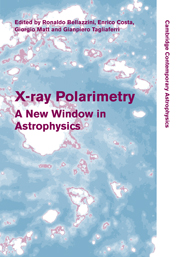Book contents
- Frontmatter
- Contents
- List of contributors
- Preface
- 1 X-ray polarimetry: historical remarks and other considerations
- Part I Polarimetry techniques
- Part II Polarized emission in X-ray sources
- 14 Probing strong gravity effects with X-ray polarimetry
- 15 X-ray polarization from black holes in the thermal state
- 16 Strong-gravity effects acting on polarization from orbiting spots
- 17 Polarization of thermal emission from accreting black holes
- 18 X-ray polarimetry and radio-quiet AGN
- 19 The soft X-ray polarization in obscured AGN
- 20 The polarization of complex X-ray sources
- 21 Polarization of Compton X-rays from jets in AGN
- 22 Polarization of X-ray lines from galaxy clusters and elliptical galaxies
- 23 Polarization characteristics of rotation-powered pulsars
- 24 Polarized X-rays from magnetized neutron stars
- 25 Polarization properties of X-ray millisecond pulsars
- 26 X-ray polarization signatures of neutron stars
- 27 Polarization from the oscillating magnetized accretion torus
- 28 X-ray polarization from accreting white dwarfs and associated systems
- 29 Polarization of pulsar wind nebulae
- 30 X-ray polarization of gamma-ray bursts
- 31 Central engine afterglow from GRBs and the polarization signature
- 32 GRB afterglow polarimetry past, present and future
- 33 Gamma-ray polarimetry with SPI
- 34 INTEGRAL/IBIS observations of the Crab nebula and GRB 041219A polarization
- 35 Fermi results on the origin of high-energy emission in pulsars
- 36 Diagnostics of the evolution of spiral galaxies in a cluster environment
- Part III Future missions
- Author index
- Subject index
34 - INTEGRAL/IBIS observations of the Crab nebula and GRB 041219A polarization
from Part II - Polarized emission in X-ray sources
Published online by Cambridge University Press: 06 July 2010
- Frontmatter
- Contents
- List of contributors
- Preface
- 1 X-ray polarimetry: historical remarks and other considerations
- Part I Polarimetry techniques
- Part II Polarized emission in X-ray sources
- 14 Probing strong gravity effects with X-ray polarimetry
- 15 X-ray polarization from black holes in the thermal state
- 16 Strong-gravity effects acting on polarization from orbiting spots
- 17 Polarization of thermal emission from accreting black holes
- 18 X-ray polarimetry and radio-quiet AGN
- 19 The soft X-ray polarization in obscured AGN
- 20 The polarization of complex X-ray sources
- 21 Polarization of Compton X-rays from jets in AGN
- 22 Polarization of X-ray lines from galaxy clusters and elliptical galaxies
- 23 Polarization characteristics of rotation-powered pulsars
- 24 Polarized X-rays from magnetized neutron stars
- 25 Polarization properties of X-ray millisecond pulsars
- 26 X-ray polarization signatures of neutron stars
- 27 Polarization from the oscillating magnetized accretion torus
- 28 X-ray polarization from accreting white dwarfs and associated systems
- 29 Polarization of pulsar wind nebulae
- 30 X-ray polarization of gamma-ray bursts
- 31 Central engine afterglow from GRBs and the polarization signature
- 32 GRB afterglow polarimetry past, present and future
- 33 Gamma-ray polarimetry with SPI
- 34 INTEGRAL/IBIS observations of the Crab nebula and GRB 041219A polarization
- 35 Fermi results on the origin of high-energy emission in pulsars
- 36 Diagnostics of the evolution of spiral galaxies in a cluster environment
- Part III Future missions
- Author index
- Subject index
Summary
Neutron stars generate powerful winds of relativistic particles that form bright synchrotron nebulae around them. Polarimetry provides a unique insight into the geometry and magnetic configuration of the wind, but high-energy measurements have failed until recently. The INTEGRAL-IBIS telescope has been used in its Compton mode to search for linearly polarized emission for energies above 200 keV from the Crab nebula. The asymmetries in the instrument response are small and we obtain evidence for a strongly polarized signal at an angle parallel to the pulsar rotation axis. This result confirms the detection recently reported by, and extends the polarization measure for all the pulsar's phases. We also report the recent observation of a variable polarization signal from the long GRB 041219A. The achieved sensitivity opens a new window for polarimetric studies at energies above 200 keV.
Introduction
Gamma-ray polarimetry has been possible with Compton telescopes since the 1970s. Photons that are Compton scattered between two detectors follow an azimuthal distribution around the source direction that allows quantification of the degree and direction of linear polarization because the photon is preferentially scattered in a plane at right angles to its incident electric vector. It was unsuccessful until recently because of intrinsic asymmetries in the detector response and nonuniformities in the large background signals. They induce pseudo-polarimetric signals, even from an unpolarized source, that limit the sensitivity to any detection.
- Type
- Chapter
- Information
- X-ray PolarimetryA New Window in Astrophysics, pp. 230 - 237Publisher: Cambridge University PressPrint publication year: 2010



